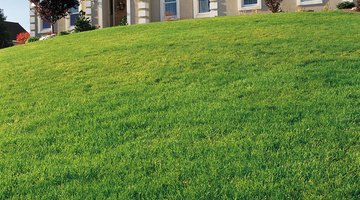How to Landscape With Rocks on a Steep Slope

A steep slope is difficult to landscape due to water erosion. Each time it rains, grass and plant roots become more exposed and eventually wash away or die from exposure. Adding rocks to the area breaks up water flow, slowing erosion, and provides stable areas for larger plants to grow. When landscaping rocks to a slope, you must stabilize the stones so they don't simply roll down the hill.
Step 1
Select random spots staggered along the slope to place your rocks. Placing the stones in a staggered pattern breaks up the flow of water and slows it down. It also traps water behind stones, allowing vegetation to thrive.
Step 2
Dig indentations in the bank to hold the rocks in place, so they are secure and have no risk of rolling down and harming individuals or property. Use a shovel to dig into the slope. As you create a more level surface, scoop out some of the soil away from the edge of the indentation.
Step 3
Make the rock areas large enough for several stones at each location. Rock groupings look better in odd-numbered clusters rather than as single stones, and they can sustain more plants at each location.
Step 4
Place rocks of different sizes together at each location along the slope. This creates a more natural look. Choose types of rock that are typically in your area, unless you're trying for a particular theme.
Step 5
Push soil up around the base of the rocks to secure them. If you're using larger rocks and are concerned about them shifting, tap metal spikes in the ground in front of them so that they protrude from the ground a couple of inches. The spikes will keep the rocks from rolling forward, and are easily hidden by landscape material or vegetation.
Step 6
Dig out areas behind the rock groupings to plant vegetation such as trees and shrubs as well as flowers and ground cover. Depending on your preferences, you might consider an ornamental grass such as feather reedgrass (Calamagrostis acutiflora) to help anchor some of the soil. Feather reedgrass grows well in U.S. Department of Agriculture plant hardiness zones 5 through 9.
Step 7
Use your shovel to dig a narrow, shallow trench around the landscaped areas. Insert edging partially in the trench and tap in the anchor spikes that come with it. Push the removed soil up around the edging to fill back in the trench. The edging is used to keep materials from washing down the hill.
Step 8
Spread a landscape cover such as mulch or pine needles inside the edged areas, insuring coverage around all the plants.
Tip
Wear protective gear when working with heavy objects. Boots will protect your feet from injury; steel-toed boots offer the safest coverage.
Things You Will Need
- Shovel
- Metal spikes
- Hammer
- Plants
- Mulch
- Edging
- Boots
References
Writer Bio
Keith Dooley has done work in the field of landscaping and design for more than 10 years. He has implemented his own designs, as well as pulled from techniques learned through studies, creating many landscapes for others to enjoy.He has also maintained lawns, athletic fields, town parks, large gardens and game fields.
Photo Credits
- Comstock/Comstock/Getty Images
- Comstock/Comstock/Getty Images
More Articles



